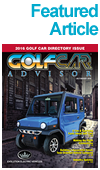Suppose you, as a STOV manufacturer, have a successful line of vehicles in a relatively narrow market niche. Your idea is to go after a broader market with new models. One of the strong points you have in implementing this strategy is the ability to basically transfer the drive train, intact with just marginal modifications, into the new vehicle line. This indicates a good start on the manufacturing side.
We all know, however, that it takes more than an efficient manufacturing scheme to successfully develop a new product line, especially if the effort will put you up against established companies well-known for their aggressive management and product development style.
A Checklist for Successful Market Entry
From what I have observed over time in an industry with numerous start-ups and many new model introductions—and especially with golf car manufacturers broadening their product lines—there are at least six critical elements to a successful product line:
- Brand recognition
- Competitive drive train
- Performance characteristics that fill a market need
- Accessories lending themselves to diversified applications
- Incentivized and capable dealer network for sales and service
- An effective marketing campaign, using all aspects of the internet and social media
Let’s take each of these elements in turn.
Brand Recognition
How it helps to have a brand that is easily and favorably recognized! John Deere and Toro, for example, are two companies widely known in lawn and turf management products and traditional work vehicles. When they entered the off-road work vehicle segment, mainly embedded within the powersports market, they had immediate credibility on the strength of their brand recognition.
If you don’t have it to start with, it has to be built, and that is part of your investment every bit as much as the factory assembly line.
Competitive drive train
Here the drive train includes engine, transmission, and transaxle. A competitive drive train means something that equals or betters the standards set by the leading brand. So, if the leading brand is Polaris, the drive train must be at least equal to, or be better than the Polaris model in the targeted market segment.
Performance characteristics that fill a market need
Emphasis is placed in the last sentence, because, if the vehicle to be introduced has four-wheel drive and the targeted market segment (i.e., as defined by task requirements) can largely get by with two-wheel drive, cost will push up price, which translates into low market share. Performance, usually associated with drive train capabilities, should be extended to ergonomic and safety features, among other product benefits. Options or standard features, such as four-wheel braking system, rack and pinion steering, and appropriate-to-the-need suspensions are all part of a carefully-crafted product offering.
Accessories
One of the real achievements of the STOV industry has been the ability to apply a basic drive train to many different uses and markets through accessories. From lighting to hitches, to winches, to plow blades, to hydraulic dump bed lift assists, these accessories not only build-out vehicle operating performance and market potential, but add nice profit margins into the bargain.
Incentivized dealer network for sales and service
Everyone in the value chain has to make money and yet some brands are notorious for at best a sketchy attention to this critical, yet obvious detail. Part of the problem is the mistaken bifurcation of the marketing and dealer relationship functions. The marketing manager concentrates on demographics and sales promotions/campaigns, while the manager of dealer relations gets into the nitty-gritty of various support functions, as well as selecting and maintaining the highest possible qualified dealers. In my not so humble opinion, these functions should be combined into one department, because they complement each other so closely.
A key part of the partnership in the area of service is the backup provided by the manufacturer with regard to parts and technical advice and tutoring.
Effective Marketing
Effective marketing in today’s marketplace can be summed up in the admonition, “Get to the internet”. And not just with a fancy website, but with the facility and the incentives to get potential buyers to dealers. Studies conclusively show that consumers prefer third party data aggregators to manufacturers’ websites. So find one and get on board. This a great tool for integrating marketing and dealer relationships.
The Pace of Growth
A successful product line introduction requires a multifaceted investment in the elements outlined above. A well-financed major can pull most of this off almost simultaneously on a national basis. What about the small guy with a dream and an obsession that he has the best product ever built? The alternative is an introduction on a limited basis and a build into greater significance over time.
A local manufacturer at the metropolitan area or State level will always draw attention simply out of regional pride. If you meet the other points of the checklist, you’ve got a business. “Made in Texas by Texans” is a great slogan you know where. And as the business grows beyond the you know where, the marketing banner can read, “Made in Texas by Texans for the Whole World”.
Last bit of advice, born of experience: At the point of expansion beyond regional endeavors, and probably before that, get a competent financial guy on your team; that is, someone who talks bottom line sense in what is often an atmosphere of “irrational exuberance”, to borrow a well-known phrase from another era.























